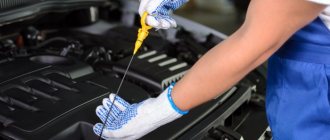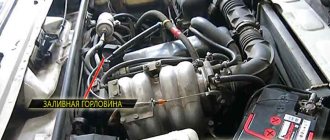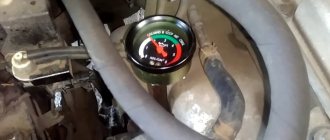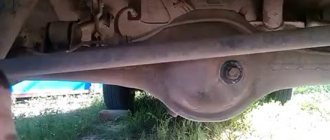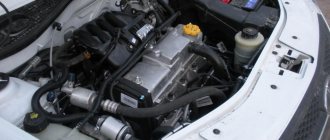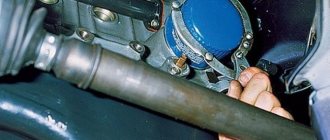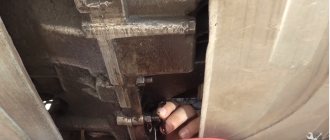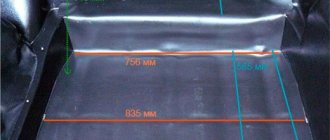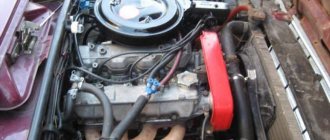Oil consumption is provided for by the engine design and cannot be equal to zero, otherwise the engine will be destroyed. At AVTOVAZ there are standards for the consumption of motor oil, and the standards are the same for all VAZ engines (starting from the VAZ 21213 engine, which is installed on the Lada 4×4, ending with modern 1.6 and 1.8 liter VAZ 21126, VAZ-21129, VAZ-21179 engines). Let's figure out how much oil a VAZ engine should consume, as well as which of the AvtoVAZ engines is the most voracious.
Reasons for increased engine oil consumption
The problem of increased oil consumption very often worries owners of those cars whose mileage is already quite high after purchase or major repairs. But even on new cars, the engine often begins to consume oil beyond measure. To understand the reason for this, first let's look at a little theory on the matter.
For domestically produced cars, such as the VAZ 2106-07, or later models 2109-2110, the permissible oil consumption during engine operation is 500 ml per 1000 km. Of course, this is the maximum, but still, such consumption is clearly not worth considering as normal. In a good, serviceable engine, from replacement to oil change, many owners do not add a single gram. This is an excellent indicator.
How often to change the oil
The frequency of changing engine oil in 2114 depends primarily on the operating conditions of the vehicle, the oil itself, and also on the mileage. If the engine has traveled more than 150 thousand km, we recommend replacing it every 10,000 km or even earlier. Some motorists change their oil even after 8,000 km. This way they extend the life of their car’s engine.
The oil filter must be changed at every oil change. The old used filter is disposed of; its re-installation is undesirable, since it has already exhausted its service life.
If you have just purchased a car, or do not know what kind of oil is filled in, we recommend that when changing the oil, you first fill in the flushing oil. The cost of flushing oil is about 400 rubles, and the flushing time is about 15 minutes. Very often, when flushing the engine, the flushing oil drains out black, which indicates oil deposits. If black oil drains out during flushing, we recommend flushing again.
What to do if the engine consumes oil after replacing the rings
If, after replacing the rings, the car begins to consume oil abundantly, then the problem in most cases is observed when installing non-original spare parts. Also, specialists always clarify information about the vehicle’s mileage. If the motor has a lot of wear, it means there are leaks.
Instructions:
- valve checking;
- head inspection;
- evaluation of seals;
- Change of oil.
If the above steps help identify an additional malfunction, then it will need to be eliminated. Otherwise, you will have to replace the rings with a more suitable one.
Oil change intervals
Let us list the factors influencing the oil change period in the VAZ-2114 engine.
- If you bought a used car, no matter what the previous owner told you about changing the oil, it needs to be changed. You don’t know for sure when the engine oil was changed and what quality it was.
- Experienced car owners recommend changing the engine oil after 10-15 thousand kilometers of the car. But for the VAZ-2114 model, it is recommended to reduce this distance to 9 thousand kilometers.
- Seasonality plays a big role in replacement. Experts agree that an oil change is also necessary when the seasons change, since the winter and summer versions of the fluid used differ from each other in their properties, which affects the quality of the car. Even if your car was parked most of the time, when the season changes, replace the engine fluid, since condensation accumulating in engines has a detrimental effect on its operation.
Having decided on the deadline, we go to choose the replacement product itself and related materials and tools.
On our website you will find:
- current information about Lada, new products in production and news related to the brand;
- statistical data on sales and the place of the Russian automobile industry in both the local and international markets;
- useful tips on operation, repair and maintenance of VAZ cars;
- all the most important information that will help you when repairing VAZ cars;
- reviews of the most common problems faced by machines.
If you have any questions regarding the repair of your car, materials and spare parts for it, you can get advice from a specialist. To do this, go to the CONTACTS section and send your question. You will find this and much more about the features of domestic cars on our portal OLADE.RU
Honda Civic Candy JDM › Logbook › Oil change based on engine hours/fuel consumption. Calculation formulas.
I consider this approach to changing oil to be more reliable in terms of its operating time than replacing it by mileage, which is often so incorrect that discussions of such a plan as “how often to change the oil” cause confusion, as there is no clear criterion for engine operating time, despite the factory’s recommendations to reduce oil in difficult conditions timing... this is also approximately... Nowadays a car costs more due to traffic jams, and in winter the lion's share of the oil's life is burned by warming up and rattling in the cold! therefore, mileage becomes secondary, although as a means of measurement, it should also not be thrown off the chart, because someone rushes along the roads for days, such as taxi drivers, their mileage is a rather objective value.
Technical characteristics of the motor 2106
After a failure with the timing belt in the internal combustion engine 2105, the manufacturer AvtoVAZ returned to the chain drive. The standard for the 2106 engine was version 2103; the cylinder diameter was increased to the original 79 mm, as in modification 21011.
Therefore, the technical characteristics of the internal combustion engine are important:
| Manufacturer | VAZ |
| Engine brand | VAZ-2106 |
| Years of production | 1976 – 2006 |
| Volume | 1569 cm3 (1.5 l) |
| Power | 64-75 hp |
| Torque | 87.3 Nm (3400 rpm) |
| Weight | 121 kg |
| Compression ratio | 8,5 |
| Nutrition | carburetor Solex 1107010-01, then 1107010, since 1980 Ozone 1107010-20 |
| Motor type | in-line |
| Number of cylinders | 4 |
| Location of the first cylinder | near the timing chain |
| Number of valves on each cylinder | 2 |
| Cylinder head material | aluminum alloy |
| Allowable warpage | manifold gaskets (intake/exhaust) 0.08 mm cylinder head gasket 0.05 mm |
| Valve seat | width 2 mm, angle 45° |
| Camshaft | one upper cylinder head inside, phase width 232°, exhaust valve advance 42°, intake valve lag 40° |
| Camshaft oil seal | diameters – 40 mm, 56 mm, width 7 mm |
| Cylinder block material | cast iron |
| Cylinder diameter | class A – 79 – 79.01 mm class B – 79.01 – 79.02 mm class C – 79.02 – 79.03 mm class D – 79.03 – 79.04 mm class E – 79.04 – 79.05 mm |
| Pistons and rings | piston made of aluminum alloy with tin coating, cast iron rings, compression outside chrome plated (top) and beveled (bottom) |
| Piston diameter | class A – 78.94 – 78.95 mm class C – 78.96 – 78.97 mm class E – 78.98 – 78.99 mm |
| Gaps | piston/cylinder wall – 0.153 – 0.173 mm (standard) or 0.19 mm (maximum) piston rings – 110 mm relative to the cut plane |
| Upper compression ring | 1.535 – 1.555 mm |
| Lower compression ring | 3.957 – 3.977 mm |
| Oil scraper ring | 2.015 – 2.035 mm |
| Gap between piston groove and ring | 0.03 – 0.07 mm |
| Crankshaft | cast iron, casting |
| Number of main bearings | 5 |
| Gearbox neck diameter | 50.795 – 50.775 mm |
| Main journal gap | 0.1 – 0.5 mm |
| Connecting rod bearings | shaft journal diameter – 47.814 mm liner thickness – 1.448 mm liner width – 28.025 – 28.975 mm |
| Crankshaft oil seals | front – diameters 42 mm, 60 mm, width 7 mm rear – diameters 85 mm, 105 mm, width 10 mm |
| Piston stroke | 80 mm |
| Fuel | AI-92 |
| Environmental standards | Euro 2 |
| Fuel consumption | highway – 7.8 l/100 km mixed cycle 9.2 l/100 km city – 12 l/100 km |
| Oil consumption | maximum 0.7 l/1000 km |
| Engine oil for 2106 | 5W-30 – 15W-40 |
| Engine oil volume | 3.75 l |
| Replacement frequency | every 55,000 km |
| Operating temperature | 80° |
| Motor life | declared 120,000 km actual 200,000 km |
| Adjustment of valves | nuts and feeler gauge |
| Cooling system | forced |
| Coolant quantity | 9.85 l |
| water pump | polymer impeller, mounted on a block |
| Ignition | distributor |
| Candles for 2106 | A17-DVR, FE65CPR, A17DV-10 |
| Gap between spark plug electrodes | 0.5 – 0.6 mm |
| Valve train chain | double-row roller, 114 links |
| Cylinder operating order | 1-3-4-2 |
| Air filter | dry with replaceable cardboard cartridge and pre-cleaner, temperature adjustment according to the season |
| Oil filter | recommended Mann W914/2 |
| Flywheel | 129 teeth, 0.62 kg bore diameter - 25.67 mm outer diameter – 27.75 mm no offsets |
| Flywheel mounting bolts | M10x1.25 mm, length 23.5 mm, |
| Valve stem seals | Manufacturers Horse or Corteco |
| Compression | pressure in the cylinders from 10 – 14 bar, pressure difference in individual cylinders within 1 bar |
| Oil temperature | 80°С |
| Thermostat temperature | 80 – 84°С |
| Valve pressure inside the radiator cap | 0.7 – 1 bar |
| Content of harmful products in the exhaust | CH <200%, CO <0.5% |
| XX speed | 800 – 900 min-1 |
| Tightening force of threaded connections | spark plug – 31 – 39 Nm flywheel – 61 – 87 Nm clutch bolt - 29.4 Nm bearing cap – 68 – 84 Nm (main) and 43.32 – 53.51 (connecting rod) cylinder head – two stages 31 – 41 Nm, 96 – 118 Nm |
The engine retains the same intake manifold, exhaust manifold, and other attachments. In principle, the entire line of internal combustion engines produced by the manufacturer of the AvtoVAZ plant, and the 2106 engine in particular, can be repaired with your own hands “on the knee” in the field.
Design of internal combustion engine with timing chain drive
The manual includes a description of the parameters that the manufacturer recommends for its engines.
How much oil to pour into the VAZ 2106 engine
First generation 2106, 1975-2006
The VAZ-2106 was a modernized three-ruble car. The developers decided to slightly reduce the cost of the car's appearance by getting rid of unnecessary chrome elements. As a result, the car received new bumpers and front fascia, different rear lights and other minor external improvements. In addition, there are new door cards inside, as well as a hazard warning button on the front panel. After 1987, a 5-speed manual transmission began to be installed instead of a manual transmission-4, and in the 1990s the design and interior were significantly simplified - metal elements were replaced by plastic parts to reduce the cost of production. But the car received a heated rear window, a contactless ignition system, halogen headlights and new seat upholstery. In the last years of production, the 2106 was offered with an 80-horsepower 1.6-liter injection engine.
Gasoline engines 1976-2001
- 1.3 64 l. With. (21011), oil volume - 3.75 liters, tolerance and viscosity: API-SG, SJ, SH; SAE 5W-30, 10W-40, 10W-30, 5W-40
- 1.45 73 l. With. (2103), oil volume - 3.75 liters, tolerance and viscosity: API-SG, SJ, SH; SAE 5W-30, 10W-40, 10W-30, 5W-40
- 1.6 76 l. With. (2106), oil volume - 3.75 liters, tolerance and viscosity: API-SG, SJ, SH; SAE 5W-30, 10W-40, 10W-30, 5W-40
The main reasons why an internal combustion engine consumes oil excessively
So, below is a list of reasons why a car engine begins to eat oil too quickly and in large quantities. I would like to immediately note that this list is not complete and is made on the basis of the personal experience of many experienced owners and specialists.
- Increased wear of the piston group: compression and oil rings, as well as the cylinders themselves. The gap between the parts becomes larger, and therefore oil begins to enter the combustion chamber in relatively small quantities, after which it burns along with gasoline. With such symptoms, you can usually notice either heavy oil deposits or a black coating on the exhaust pipe. A major overhaul of the engine, replacement of piston group parts and boring of cylinders if necessary will help eliminate this problem.
- The second case, which is also quite common, is wear of the valve stem seals. These caps fit onto the valve from the top side of the cylinder head and prevent oil from entering the combustion chamber. If the caps become leaky, the consumption will correspondingly increase and the only solution to this problem will be to replace the valve stem seals.
- There are times when everything seems to be fine with the engine, and the caps have been changed, but the oil continues to fly away into the pipe. Then you should pay special attention to the valve guides. Ideally, the valve should not dangle in the bushing and the gap should be minimal. If the play is felt by hand, and especially strong, then it is necessary to urgently change these same bushings. They are pressed into the cylinder head and it is not always possible to do this at home, although most succeed.
- Oil leakage through oil seals and gaskets in the engine. If you are sure that everything is fine with the engine, and cannot understand why the oil is leaking, you should pay attention to all the gaskets, especially the pan. And also check the seals to see if they are leaking. If damage is found, the parts must be replaced with new ones.
- It is also worth keeping in mind that your driving style directly affects how and how much oil your engine will consume. If you are used to a quiet ride, then you should not have any problems with this. But if, on the contrary, you squeeze everything out of your car that it is capable of, constantly operate it at high speeds, then you should not be surprised at the increased oil consumption.
These were the main points that are worth considering if you suspect that your internal combustion engine's appetite for fuel and lubricants has increased. If you had a different experience, you can leave your comments below on the article.
Source
Elimination of oil stain
High oil consumption is not a death sentence. There are several ways to solve the problem, and ultimately only the car owner will be able to understand which one will be the most optimal.
Eliminate increased oil consumption
First, read the instruction manual and make sure that the manufacturer did not include such consumption. But if this should not happen, one of the following procedures will help correct the situation. For convenience, we have sorted them according to the order in which the work was performed in order to solve the oil burn problem, indicating average prices.
- Replacing the air filter.
From 300 to 1500 rubles. - Internal engine cleaning with hydrogen (decarbonization).
From 2000 rub. The procedure is carried out without changing the oil and without disassembling the internal combustion engine and is good because you can not only solve the problem of oil leakage, but also improve the performance of the engine and associated systems, while increasing its service life. - Change of oil.
The cost of the procedure will be on average around 500 rubles + the cost of oil from 2000 to 20,000 rubles. - Chemical decarbonization.
From 2500-3000 rubles*. Today you can easily find means for cleaning yourself, but be careful - chemicals can save you not only from carbon deposits, but also from the pan and seals. It is also important to remember that after this procedure an oil change is required.
*price already includes replacement with cheap oil.
- Replace oil seals.
From 7000 rub. It makes sense if decarbonization did not help, but the guide valves are in order. - Oil seal repair.
From 1000 to 5000 rub. If decoking doesn't help and you have a mechanical problem (leakage). - Removing and cleaning spark plugs.
From 500 to 1000 rub. Replacement of spark plugs from 2000 to 5000 rubles. - Removing and cleaning injectors.
From 3000 to 6000 rubles. Replacement of injectors from 3,000 to 20,000 rubles. - Removing and cleaning valve guides.
From 3,000 to 30,000 rubles. Replacement of valve guides from 10,000 to 50,000 rubles. - Removing and cleaning the EGR valve.
From 10,000 to 20,000 rubles. Replacement of the USR valve from 20,000 to 60,000 rubles. - Removing and cleaning the turbocharger.
From 10,000 to 40,000 rubles. Replacement of a turbocharger from 30,000 to 150,000 rubles. - Engine overhaul.
The most expensive and complex procedure in which the engine is completely disassembled and all faulty components are replaced. The cost starts from 50,000 rubles.
Hydrogen cleaning
The essence of this procedure is to produce, using special equipment, detonating gas, consisting of two-thirds hydrogen gas and one-third oxygen. During the oxidation of hydrogen in the combustion chamber, conditions are created for the effective oxidation of highly concentrated carbon. When hydrogen burns, it creates a pulse, the energy of which initiates the transition of carbon from a solid state of aggregation to a gaseous state. Simply put, when carbon oxidizes, it becomes a gaseous substance, ordinary carbon dioxide CO2, which leaves the engine through the exhaust system of a car engine.
As a result of the procedure, the following occurs: the engine characteristics are reset to factory settings, power and efficiency increase, and lubricant and fuel consumption decreases. That's why we keep hydrogen cleaning separate from the rest. Unlike many other options, this method affects not only excessive oil consumption, but also the operation of all engine systems as a whole. In this case, absolutely no damage is caused to the engine!
Hydrogen decarbonization not only cleans oil scraper rings, pistons and the combustion chamber, just like chemical decarbonization, but also allows you to remove a significant part of the carbon deposits from spark plugs, injectors, USR and guide valves, turbocharger, clean the catalyst and particulate filter. You can solve one problem or prevent a whole series of others at once.
Of course, hydrogen cleaning is not a panacea. In any case, no one can set priorities and allocate the budget better than you. We only encourage you to consider in detail all the solutions in order to choose the most effective one for you.
Do you have a question?
Write to us if you have questions or would like to schedule a cleaning: https://cleanengine.ru/
Service station address and contacts:
St. Petersburg, St. Petersburg, Polyustrovsky pr. 87 lit. O +7
What engine can be installed on a VAZ 2106 instead of the standard one?
The main advantage of the “six” is its versatility. Owners of domestic VAZ 2106 cars can tune both the engine and the body with virtually no restrictions.
Domestic options
Power units from any VAZ model can be ideally suited to the VAZ 2106. However, do not forget that the replacement motor must be of the same size, weight and approximately the same power as the standard one - this is the only way to safely and efficiently change the engine without any modifications.
AvtoVAZ engines can be considered the best options for replacement:
- VAZ 2110;
- VAZ 2114;
- "Lada Priora";
- "Lada Kalina".
The domestic power unit is capable of giving the “six” additional power and increasing the service life of the machine
The main advantage of such a replacement is the ease of registering a car with a new engine with the traffic police. You will only have to indicate the new identification number, since the manufacturer will remain the same.
Engine from a foreign car
To increase the power of the “six”, you will have to find more “serious” types of engines. Without changing the engine space in the car, you can install engines from Nissan or Fiat on the VAZ 2106.
From the European ones, the Fiat 1200 ohv engine will be used as a native one. Minimum alterations.
Lazy-b0nes
https://forums.drom.ru/retro/t1151790175.html
However, for thrill-seekers this power may not be enough. The VAZ 2106 can easily be equipped with an engine from the BMW 326, 535 and 746 models. However, it should be borne in mind that with an increase in power, the entire structure of the car as a whole will have to be strengthened. Accordingly, investments will be required to strengthen the suspension, brakes, branches in the cooling system, etc.
Installing an engine from imported cars involves significant modifications in the engine compartment and in the design of service systems
Diesel engine for VAZ 2106
It was advisable to install diesel power plants on gasoline domestic cars several years ago, when the cost of diesel fuel was lower than AI-92. The main advantage of a diesel engine is its efficiency. Today, the cost of diesel fuel exceeds the price of gasoline, so there can be no talk of any efficiency.
However, lovers of increased engine thrust can easily install various diesel units on the VAZ 2106. Three rules must be followed:
- The dimensions and weight of a diesel engine should not greatly exceed the weight of a standard VAZ engine.
- You cannot install engines with a power of more than 150 hp on the “six”. without corresponding modifications to the body and other systems.
- Make sure in advance that all vehicle systems will connect safely to the new engine.
The diesel engine will give the car additional traction and mobility.
Is it worth installing a rotary engine?
Today, only the Mazda concern uses rotary engines to equip its cars. At one time, AvtoVAZ also produced rotary piston engines, but due to the problematic nature of the device, it was decided to stop equipping cars with such installations.
Installing a Mazda rotary engine on a VAZ 2106 will not allow you to do it without intervention: you will need to expand the engine compartment and modify a number of systems. If you wish and have the funds, all these tasks are feasible, but it is more advisable to install an engine from a Fiat, for example, since with a small investment it will give the car the same speed characteristics.
The operation of a rotary engine is noticeable in the exhaust: exhaust gases leave the engine cavity faster
Thus, the VAZ 2106 engine can be replaced either with a similar one from other VAZ models, or with an imported one from more powerful foreign cars. In any case, replacing the power unit must be approached as responsibly as possible - because if the connection is incorrect or the recommended rules are not followed, it will be unsafe to drive such a machine.
Which substance is better?
If you have recently purchased a used 2114 car and do not know what oil the old owner used, then it is recommended:
- drain the used mixture
- fill in high-quality semi-synthetic oil,
- travel more than half the recommended period,
- drain the mixture
- Fill in the lubricant of your choice.
According to the regulations, it is recommended to replace the lubricant in Zhiguli model 2114 every 9 thousand kilometers. Fuel consumption and the number of gears have a direct impact on this indicator.
Wide range of lubricants
For VAZ cars manufactured before October 2000, it is recommended to use standard oil fluid. Engineers advise owners of Zhiguli 2109 to fill in lubricant from such manufacturers as AZMOL SUPER, LUKOIL-STANDARD, TNK Motoroil, FORMEL SUPER, SHELL HELIX 10W-40 and others. These substances are developed taking into account all the requirements of environmental standards.
We recommend: How to paint over scratches on a car?
For model 2114, the following oils are recommended:
- LADA-SUPER 5W-40, 10W-40, 15W-40;
- LUKOIL SUPER 5W-30, 5W-40, 10W-40, 15W-40;
- TNK SUPER OIL 5W-40, 10W-40, 15W-40, 20W-40;
- MOBIL SUPER M15W-40.
These mixtures are designed taking into account the presence of a catalyst in the car. Engines of all VAZ models manufactured after October 2000 should be filled with “super” category oils. Such substances have high physical and chemical properties. The best option for 2114 is Helix HX7 5W-40. This highly refined mineral type motor oil has the following characteristics:
- presence of a faint carbon odor,
- constant viscosity level until the next mixture change,
- hardening at -39 °C,
- slight solubility in water,
- regular use of the fluid reduces fuel consumption by effectively removing dirt from the surfaces of engine parts,
- reduction of noise and vibration,
- used for gasoline engines with injection and diesel engines with turbocharging.
Constructive decisions
- major repairs were required more often due to burnout of valves;
- Unstable operating modes on low-quality domestic fuel.
Valves burnout
The engine was equipped with pistons from a VAZ 21011, there was no need to reconfigure the equipment, and the cost price was not affected.
Disadvantages and advantages
The 2106 engine has significant disadvantages:
- excess heat is transferred to the well of the piston bottom and fins by steel control plates inside the bosses;
- dynamic loads are reduced due to the displacement of the finger from the axis of symmetry to the right;
- When assembled into an engine, the pistons are mounted with markings in one direction, which increases labor costs and the human factor.
Piston 2106
The internal combustion engine uses a cylinder head from model 2103, a starter 35.3708 and a G221 generator for an engine with a current of 42A. Oil consumption does not exceed 700 g/1000 km. The instruction manual states that it is recommended to add 200 ml less lubricant than the volume of the system as a whole. The markings for which oil to pour are given in the upper table.
Criteria for selecting VAZ 2106 oil
All oils are selected based on compliance with SAE, ACEA, API.
- In terms of composition, it is optimal to use semi-synthetics for used VAZs.
- ACEA A3/B3-B4.
- API SF for models up to 2000, for more recent API SG, SJ. VAZ 2106 was produced until 2006 inclusive.
AvtoVAZ offers the following table to select the appropriate viscosity:
| Minimum engine cold start temperature, °C | Viscosity grade according to SAE J 300 | Maximum ambient temperature, °C |
| -35 | 0W-30 | 25 |
| -35 | 0W-40 | 30 |
| -30 | 5W-30 | 25 |
| -30 | 5W-40 | 35 |
| -25 | 10W-30 | 25 |
| -25 | 10W-40 | 35 |
| -20 | 15W-40 | 45 |
| -15 | 20W-40 | 45 |
But most often, drivers pour 10w-40 into models with significant mileage, into more recent 5w-30.
Information on viscosity for a specific engine can be found in the motor oil interchangeability catalog: https://www.northsealubricants.com/en/oil-advisor
The catalog can be trusted, the data is taken from car manufacturers. In this case, you can choose not only oil for the engine, but also for the gearbox, power steering, brake system, and cooling system. That is, all liquids.
Maintenance Procedure
The classic design of the internal combustion engine allows you to get by with simple steps when servicing the engine:
| Maintenance object | Time or mileage (whichever comes first) |
| Timing belt | replacement after 100,000 km |
| Battery | 1 year/20000 |
| Valve clearance | 2 years/20000 |
| Crankcase ventilation | 2 years/20000 |
| Belts that drive attachments | 2 years/20000 |
| Fuel line and tank cap | 2 years/40000 |
| Engine oil | 1 year/10000 |
| Oil filter | 1 year/10000 |
| Air filter | 1 – 2 years/40000 |
| Fuel filter | 4 years/40000 |
| Heating/Cooling Fittings and Hoses | 2 years/40000 |
| Coolant | 2 years/40000 |
| Oxygen sensor | 100000 |
| Spark plug | 1 – 2 years/20000 |
| Exhaust manifold | 1 year |
As the actual life of the internal combustion engine increases, consumables may be replaced more frequently than specified, or operations for cleaning the carburetor, engine, jets, and other attachments may be added.
Motor maintenance
Injection modification
The first in the line of internal combustion engines of the AvtoVAZ manufacturer, the 2106 engine received tuning in the form of distributed injection. At the same time, the owners received a headache:
- intense heating, since the mixture is lean, the manufacturer’s cooling system cannot cope with temperature loads;
- increased fuel consumption up to 13 l/100 km in winter.
Injection 2106
A positive feature is the low budget for major repairs within 10,000 rubles.
Car service or fixing the breakdown yourself?
There may be close to fifty reasons for excessive oil consumption, but the average user cannot check them all. Trying to fix the defect yourself, for example by adding a thickener to the engine oil, can only help in the short term. Sometimes changing the quality of the oil to a more viscous one improves the situation. However, to accurately and unambiguously determine the cause of excessive oil consumption and effectively eliminate the defect, appropriate technical means are required. That is why we recommend contacting a good car service center for advice from a specialist. Only then will we have a real opportunity to completely restore the engine without exposing ourselves to unnecessary costs.
Source
Normal oil consumption per 1000 km
Certain parameters help assess the condition of a car engine, for example, oil consumption. For power units of different types, normal level indicators differ; in addition, oil consumption is determined by wear of parts. When parameters are exceeded, this is a reason to conduct diagnostics or check how high-quality lubricants are used.
